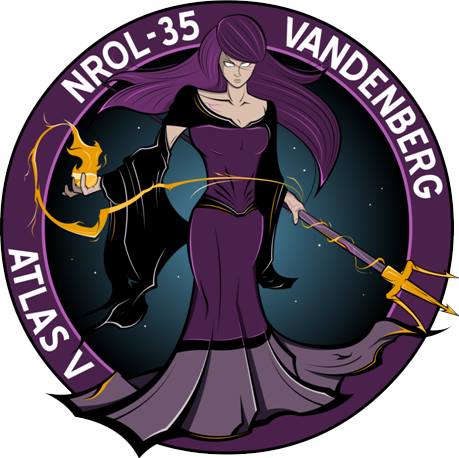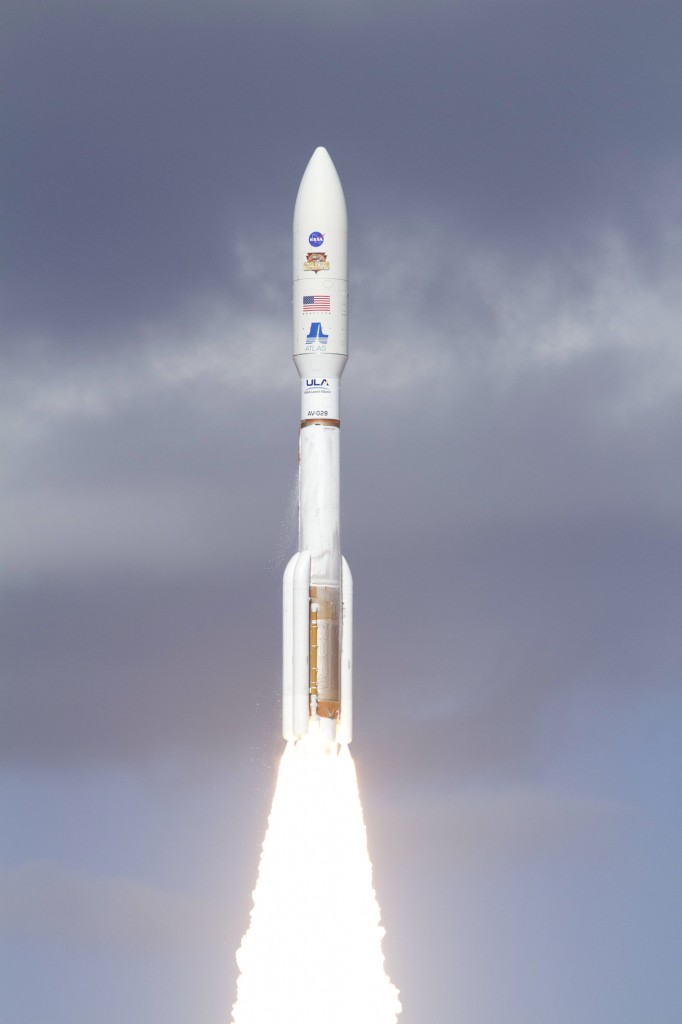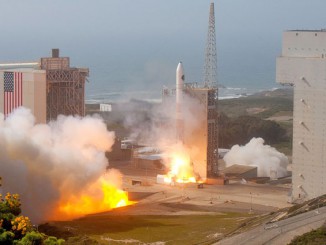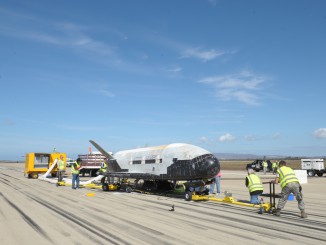
The most powerful Atlas rocket to ever fly from the West Coast is poised for launch Thursday to deliver a secret payload into orbit while debuting a new upper stage engine.
Lifting off on two million pounds of thrust, the 20-story rocket will fire away from Vandenberg Air Force Base in California some time between 6 and 8 p.m. local time (9-11 p.m. EST; 0200-0400 GMT).
The exact time is classified until closer to launch.
“This is the most powerful Atlas vehicle ever launched from Vandenberg Air Force Base, and that’s a history of decades of launching Atlases from here at Vandenberg,” said Lt. Col. Jim Bodnar, 4th Space Launch Squadron commander at the base.
Vandenberg’s first Atlas was an Intercontinental Ballistic Missile that blasted off from the base on Sept. 9, 1959. This will be 294th Atlas launch from Vandenberg and the 10th Atlas 5.
It is known as the 541 configuration in the Atlas 5 family, with a five-meter fairing, four solid rocket boosters and a single-engine Centaur upper stage.
Stacking of the rocket on the launch pad began in mid-September and took about three weeks to complete. The first stage and four solids were erected, followed by the interstage and Centaur. The satellite with its 68-foot-long payload fairing got delivered to the pad on Nov. 21.
“It’s quite an exciting time for us here,” said Capt. Jason Krahmer, the launch’s mission manager with the 4th SLS. “We have just a handful of tasks to complete before launch.”
Modifications had to be performed on the mobile service gantry to accomodate the four solid motors, Bodnar said.
The mission is known simply as NROL-35, a classified satellite-delivery flight for the U.S. National Reconnaissance Office. The NRO is the secretive government agency that controls the country’s spy satellites.

Powering the United Launch Alliance rocket off the pad will be the RD-180 main engine at the heart of the vehicle’s Common Core Booster and four strap-on solid-fuel motors for added thrust. The 541 vehicle configuration previously launched NASA’s Mars Curiosity rover to the red planet in 2011 and an NRO mission from the Cape earlier this year.
Sitting atop the first stage is the Centaur, the high-energy, cryogenic upper stage that will fire to put the clandestine payload into the proper orbit. The new powerplant — the RL10C-1 — is making its first flight on this launch.
It is the latest evolution to the famed RL10 engine that dates back over 50 years and has launched spacecraft to every planet in our solar system.
Aerojet Rocketdyne builds the RL10 engines for ULA. The engines burn liquid hydrogen and liquid oxygen, can fire multiple times and have a distinguished reliability record.
“In developing the RL10C-1, Aerojet Rocketdyne and ULA built on the successful heritage of the RL10A and B models. The RL10C-1 operating parameters are bounded by limits established during testing and years of flight experience on those earlier models,” ULA said in written answers to Spaceflight Now.
“The RL10C-1 team created a comprehensive certification test program, using established processes and procedures, which successfully certified the RL10C-1 with more operating margin than any previous RL10 version. That certification success, coupled with the results of successful acceptance testing of 9 production engines to date, gives us very high confidence in the success of our upcoming mission and future flights using the RL10C-1 engine.”
The decision to change Atlas over to the RL10C was an economic one. ULA was faced with a stockpile of unused RL10B-2 engines for Delta, so retrofitting them for Atlas was an obvious choice.
“The RL10C was developed to provide reliable and cost-effective launch services for our customers. United Launch Alliance has an inventory of RL10B-2 engine hardware which was originally produced in a large quantity at an attractive cost basis,” ULA said.
“ULA and Aerojet Rocketdyne developed a plan to utilize some of that RL10B-2 hardware inventory to develop RL10C-1 engines that are less expensive than new-build engines and also provide exceptional reliability. Increased commonality in the production and test processes provides for long term reliability and savings for our customers for both Atlas and Delta launch systems.”

First flown in 1962, the Centaur is having its 199th pairing with Atlas on this launch. Centaurs with dual RL10 engines also flew aboard Titan rockets, making this the 222nd Centaur launch and the 455th production RL10 to fly.
The RL10C blends the configurations of the RL10A engine from Atlas and the RL10B engine currently used to power the Delta 4.
- RL10A-4-2: 22,300 pounds of thrust
- RL10B-2: 24,750 pounds of thrust
- RL10C-1: 22,890 pounds of thrust
The noticeable change on the RL10C is a shortened version of the carbon-carbon nozzle extension used by Delta. Other mods include avionics for active propellant mixture ratio control, a capability currently on the Atlas’ RL10A engines but not on the Delta’s RL10B version and a redundant dual direct spark ignition system that was standard on the Atlas.
“The turbomachinery configuration on the RL10C is common with the RL10A, but the RL10C adopts the chamber and injector configuration from the RL10B,” ULA said.
“The RL10C also benefits from a ‘best of’ philosophy, incorporating reliability enhancements selectively taken from the RL10A or RL10B, including the redundant solid-state ignition system from the RL10A with design and producibility improvements.”

While debuting on Atlas 5, the new engine also will fly aboard Delta 4 rockets in the future in the RL10C-2 configuration as a common upper stage powerplant system across the ULA Evolved Expendable Launch Vehicle product lines. An exception will be for the two-engine version of the Atlas 5’s Centaur, which will use the RL10A-4-2 version side-by-side due to the size constraints with the RL10C-1 nozzles.
“We plan to continue flying out our RL10B-2 engines on Delta 4 for the next several years. For Delta 4 missions beyond that timeframe, ULA and AR are developing and certifying the RL10C-2 engine variant to supersede the B-2. The RL10C-2 will incorporate all of the RL10C-1 design upgrades along with new changes, including additive manufacturing for specific components.”
The RL10C development and test program was comprehensive, officials said, utilizing two engines to certify the RL10C-1 for use on the Atlas-Centaur launch vehicle.
“Each of these certification engines demonstrated more than 5,000 seconds of operating time. One of the two engines also underwent testing to simulate environmental conditions during boost phase at two times flight levels. The RL10C-1 provides a 20 percent increase over previous RL10 versions for both hot fire time and the number of starts during acceptance testing.”
It will be the 9th and final Atlas launch of the year, the third to originate from Vandenberg and the California base’s 10th Atlas 5 overall. It is ULA’s 91st launch since formation in 2006 and the 14th and last of 2014.



